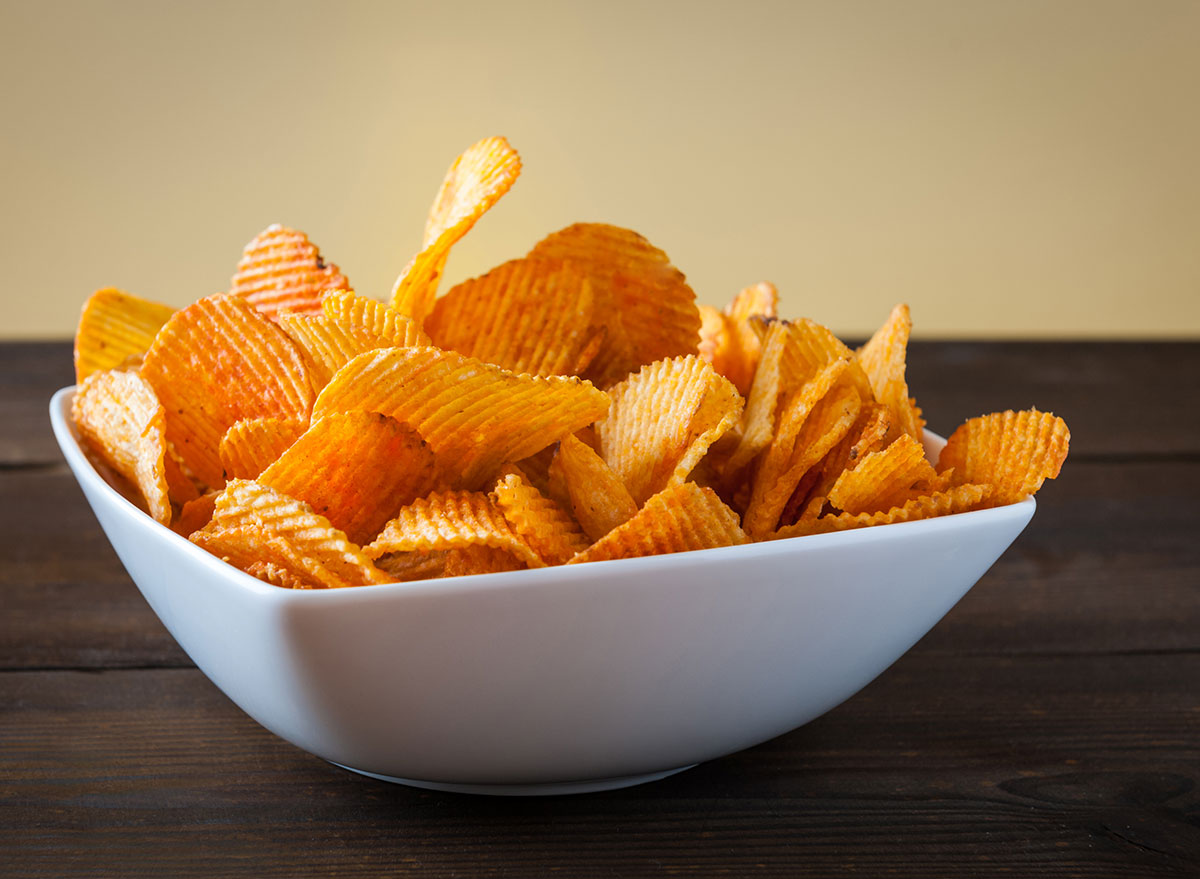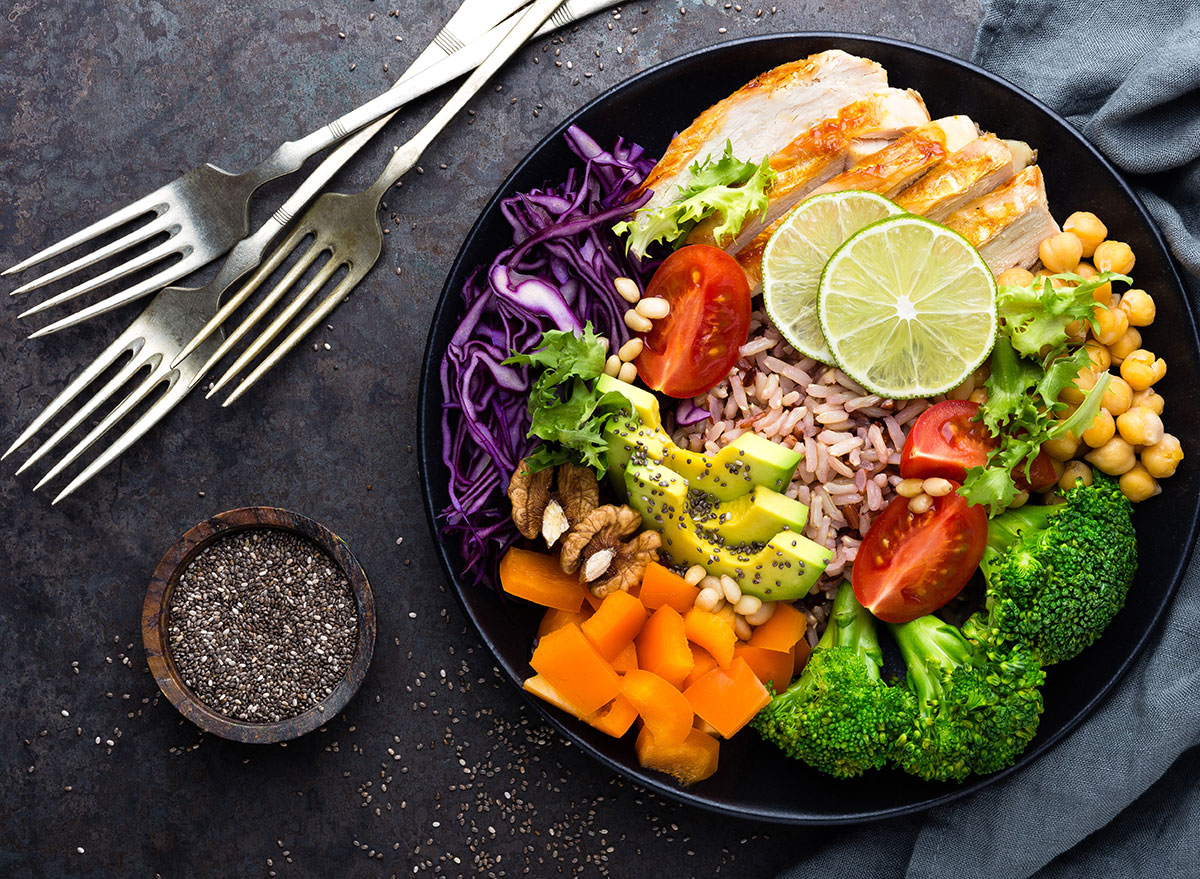Ugly Side Effects of the American Diet, Say Dietitians

You may not be familiar with the term, but it's likely you are aware of the concept behind the Standard American Diet (SAD). Imagine all of the typical "American" foods and put them all together—burgers, french fries, pizza, soda, sugary cereals, packaged and processed foods, ice cream, the list goes on. While enjoying these types of foods once in a while is okay for an overall healthy, balanced diet, consuming them on a regular basis can cause some ugly side effects on your body's health.
According to a report titled Front-of-Package Nutrition Rating Systems and Symbols, the Standard American Diet involves a diet that is too high in calories, saturated fats, trans fats, added sugars, and sodium. It involves very little intake of essential nutrients for the body like fiber, calcium, potassium, and vitamin D.
The biggest takeaway of the Standard American Diet is how this diet lacks fruits and vegetables, which is the best way to get a variety of nutrients into your diet.
"A 2010 report from the National Cancer Institute found that nearly the entire U.S. population consumes a diet that is not on par with recommendations," says Theresa Gentile, MS, RDN, CDN, owner of Full Plate Nutrition. Gentile also points out from The American Cancer Society that around 18% of cancer cases are related to poor nutrition and lack of exercise.
The development of a serious chronic disease like cancer isn't the only ugly side effect of regularly consuming the Standard American Diet, hence why it's been deemed The #1 Worst Diet For Americans.
You'll likely experience weight gain.

"The SAD is the typical American diet which emphasizes red meat, processed foods, refined grains, sugary foods including sodas, with low consumption of fresh fruit, vegetables, fish, whole grains, beans, and legumes," says Lisa R. Young, PhD, RDN, author of Finally Full, Finally Slim, and a member of our medical expert board. "It is low in fiber, antioxidants, and too high in calories, saturated fat, sugar, and salt."
Because of the types of foods that are in (or lacking) in the SAD, weight gain can easily become a side effect of consuming such foods regularly.
"It has contributed to the high rates of obesity and overweight in the US (nearly 75% of the population is overweight or obese)," says Young. "It has also led to diet-related chronic diseases, such as heart disease, hypertension, type 2 diabetes, and certain cancers."
You may experience constipation.

"Most Americans don't get enough fiber, which is needed for healthy digestion," says Jinan Banna, PhD, RD. "The SAD is poor in fruits and vegetables, whole grain, legumes, and other such foods. This is just one of the digestive issues that might arise."
The Dietary Guidelines for Americans recommend adults consume between 25 to 38 grams of fiber a day, but reports show that Americans only get an average of 10 to 15 grams daily. A lack of dietary fiber can cause issues with the digestive tract as well as the colon.
"Fiber is essential for heart health as soluble fiber (found in oats and foods made with oat flour, almonds, and seeds, fruit where you eat the skin, etc.) can help keep total and bad cholesterol low," says Amy Goodson, MS, RD, CSSD, LD, author of The Sports Nutrition Playbook, and a member of our medical expert board. "Fiber also plays a role as a prebiotic in gut health, helping to feed the good gut bacteria, as well as it helps 'push stuff through' your system improving regularity."
Here are the Dangerous Signs You're Not Eating Enough Fiber.
You may have chronic, low-level inflammation.

The types of foods typically consumed in the SAD are foods linked to chronic inflammation, which according to Trista Best, MPH, RD, LD from Balance One Supplements, can wreak havoc on one's physical, mental, and emotional health.
"Chronic, low-level inflammation causes oxidative stress in the body that leads to many of the chronic conditions common to Western nations," says Best. "Foods known to be inflammatory include gluten, refined carbohydrates and sugar, and generally all processed foods made from refined or enriched sources—all of which are the basis of SAD."
"These foods are inflammatory because the body has a difficult time breaking them down through natural meals like enzymes and good gut bacteria," Best continues. "This leads to an inflammatory response in the body's immune system, which is typically a natural and wanted reaction but in some cases, it is an overreaction from otherwise harmless foods."
Best points out that inflammation can lead to the development of chronic diseases like heart disease, obesity, and diabetes.
There's an increased risk of heart disease.

"With popular foods like hamburgers, deli meats, and fried foods–the Standard American Diet contains excessive amounts of saturated fat and sodium," says Mackenzie Burgess, RDN and recipe developer at Cheerful Choices. "This can be problematic as too much saturated fat has been found to raise blood cholesterol levels which may increase the risk of heart disease. Too much sodium can also be an issue as it's linked to high blood pressure, which is another risk factor for heart disease."
Burgess recommends looking for ways to cut down on the saturated fat and sodium in your diet with small swaps. Focusing on healthy sources of fat like fish, avocados, and nuts can promote heart health, and purchasing lower-sodium products in the grocery store (soups, sauces, unprocessed meats, to name a few).
As well as other diseases.

While chronic inflammation and too much saturated fat or sodium do play a major role in the development of chronic diseases, simply overconsuming calories can also cause an increased risk.
Shannon Henry, RD with EZCare Clinic, points out four different diseases that can develop from following a high-calorie diet—either from consuming high-calorie foods or simply consuming too many foods or drinks in general. These include type 2 diabetes, brain strokes, coronary artery disease, and kidney and gallbladder defects.
"Our passion for fast food, in particular, is sad," says Henry. "Although the federal government recommends taking at least two to five cups of fruits and vegetables a day, for example, surveys show that the average American eats only three servings a day, and 42% say we eat less than two servings."
SAD lacks essential nutrients for overall health.

"Many Americans suffer from the concept of being overfed with calories, but undernourished from valuable and essential nutrients," says Amy Goodson. "The calories they are consuming are heavily from saturated fat and added sugars, while consuming very little fruits, vegetables, and whole grains that provide vitamins, minerals, fiber, antioxidants, and more."
These types of foods are rich in vitamins and minerals that are essential for your body's health, and typically bring the "color" to your meals.
"Typical American diets often lack colorful fruits, vegetables, and other whole foods," says Burgess. "This means most Americans are missing out on the countless benefits of fruits and vegetables such as their antioxidant, anti-inflammatory, and cancer-fighting effects. Additionally, diets low in colorful fruits and vegetables may have inadequate amounts of important nutrients such as potassium, fiber, folate, vitamin A, and vitamin C."
Burgess recommends finding simple ways to add fruits and vegetables to your meals, like adding berries to yogurt, bell peppers to pasta, or leafy greens in your lunch wraps. Plus, you can easily use these 15 Best Frozen Fruits & Vegetables to Keep on Hand.
Your bone health & digestive health take a toll.

"Following the SAD may lead to poor bone health, as these foods are typically low in bone-building nutrients, like calcium, Vitamin K, and Vitamin D," says Sarah Schlichter, MPH, RDN.
"Additionally, a diet low in whole grains, legumes, fruits, and vegetables may also impact metabolism and digestion," Schlichter continues. "High fiber foods can help improve gut health and digestion while relying on ultra-processed foods reduces the diversity of bacteria in the gut microbiome, which has implications on mood and overall health as well."
Your energy levels will deplete.

A change in your gut microbiome isn't the only reason your energy levels will feel depleted after following the SAD.
"Americans coast to coast skip meals, eat large amounts of carbohydrates with little high-quality protein, fill up on sugar-sweetened foods and beverages, and those habits can set you up for blood sugar spikes and drops," says Goodson.
Because of this type of diet, Goodson points out that your blood sugar levels will spike and drop throughout the day like a "roller coaster," which can negatively affect your energy levels.
"The way to combat this is to eat balanced meals with high-fiber carbohydrates and protein every few hours," she says.
An easy solution: Add color to your plate!

"The ACS recommends at least 2 1/2 to 3 cups of vegetables and 1 1/2 to 2 cups of fruit each day for cancer prevention and USDA recommends 5 to 9 servings per day of fruits and vegetables," says Gentile. "This goal can easily be reached by incorporating a fruit or vegetable at every meal and incorporating more vegetable-based meals into your rotation, which can lower your cancer risk."
For even more healthy eating tips, read these next:








